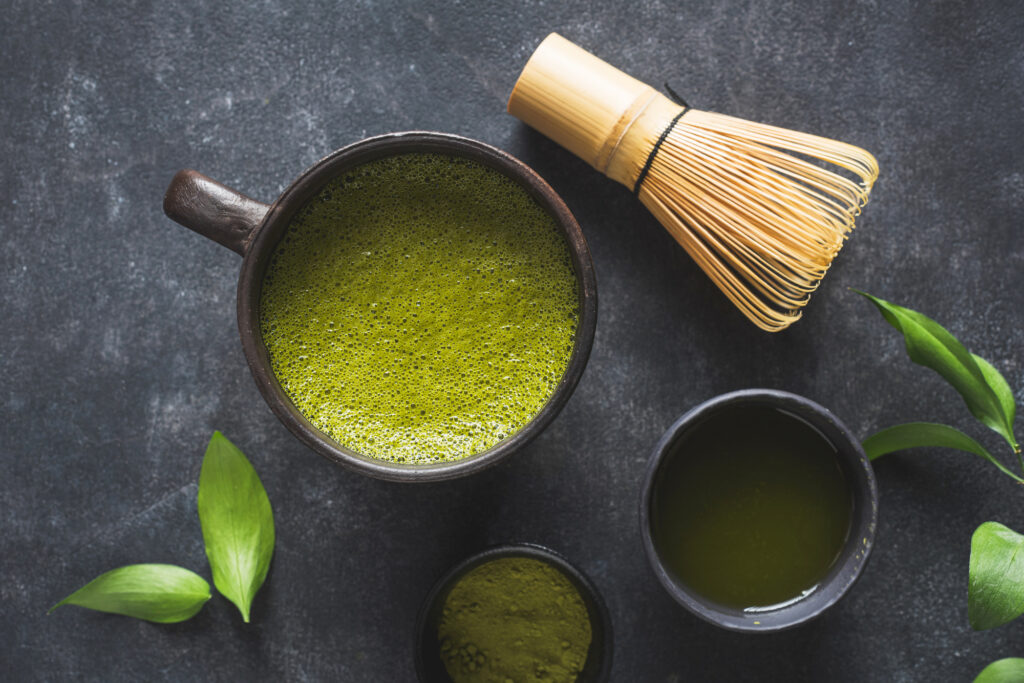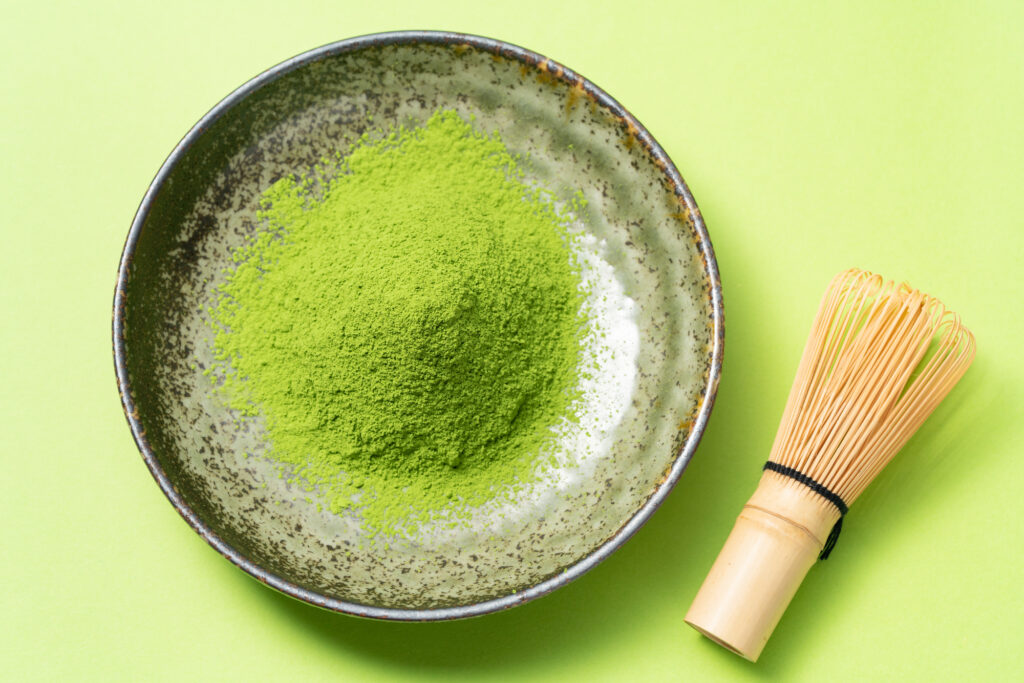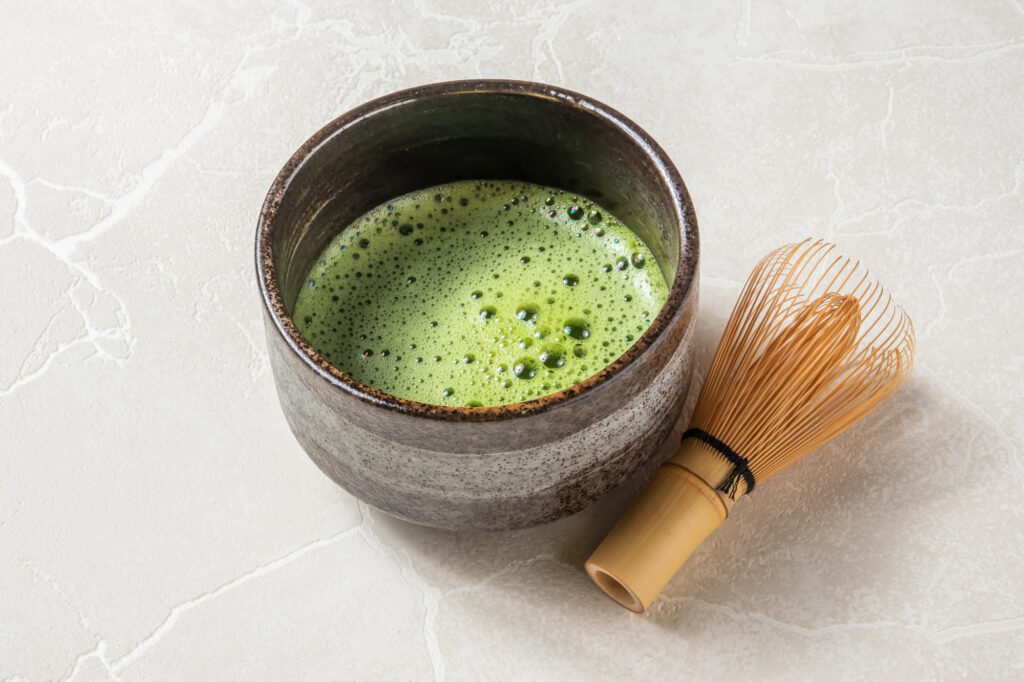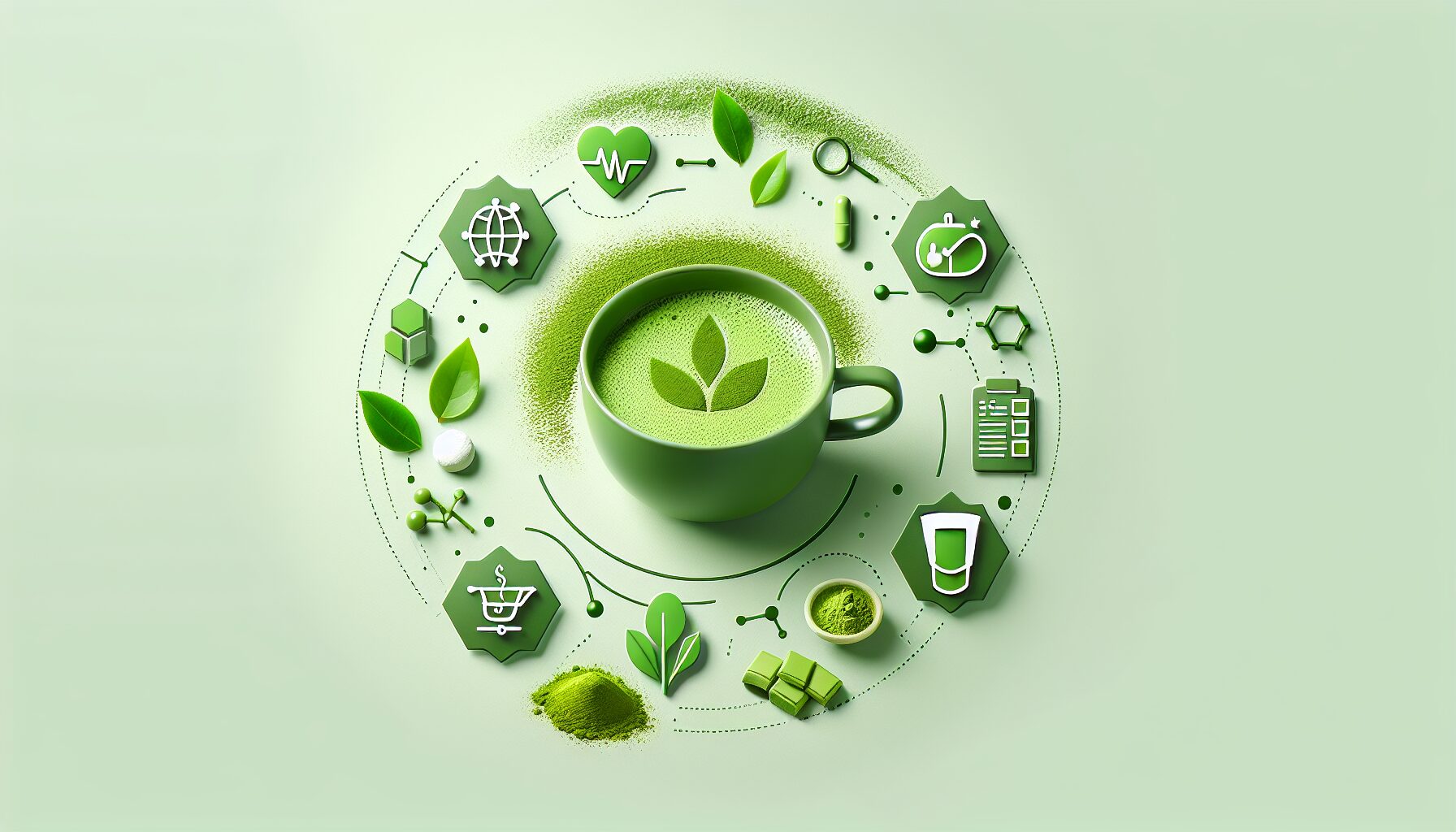The Role of Catechins in Matcha
What are Catechins? The Key to Health in Matcha
When you take a sip of matcha, that characteristic astringency and aroma spreads throughout your mouth. The source of this flavor is a compound called “catechin.” Catechins in matcha are not just flavor enhancers but have remarkable functions that provide various health benefits.

Catechins are a type of polyphenol, and matcha contains about three times the amount found in regular green tea. This is because matcha involves consuming the entire tea leaf in powdered form, allowing you to ingest all the nutritional components. According to a survey by the Japan Tea Central Association, matcha contains approximately 500-600mg of catechins per 10g, which is about 2-3 times that of sencha (brewed green tea).
Five Main Functions of Matcha Catechins
- Powerful Antioxidant Effect
Catechins in matcha have antioxidant properties that remove free radicals in the body. Since free radicals cause aging and various diseases, regular matcha consumption can reduce cellular oxidative damage. - Promotion of Fat Burning
According to research in the Journal of the American Nutrition Society, catechins in matcha can activate metabolism and promote fat burning. In particular, a type of catechin called EGCG (epigallocatechin gallate) has been confirmed to enhance the activity of fat-decomposing enzymes. - Blood Sugar Stabilization
Catechins have the ability to moderate sugar absorption, inhibiting rapid rises in blood sugar after meals. A 2019 clinical study showed that a group who consumed matcha before meals had about a 15% lower rise in blood sugar compared to a control group. - Improved Immunity
Catechins have the effect of suppressing the proliferation of viruses and bacteria, helping to prevent infectious diseases such as colds. In particular, research has shown effects on inhibiting the proliferation of influenza viruses. - Cardiovascular Health Maintenance
Catechins have effects on lowering blood pressure and bad cholesterol, contributing to reducing the risk of heart disease and stroke.
Matcha catechins are relatively resistant to heat, so you can enjoy many of their health benefits even when used in confectionery and cooking. By incorporating matcha into your daily routine, you can enjoy both delicious taste and health benefits simultaneously.
What is Matcha? Japan’s Traditional Tea Leaf Rich in Catechins
Matcha is a traditional Japanese green tea made by carefully grinding tea leaves into powder with a stone mill. It differs significantly from regular green tea in that you consume the tea leaves themselves. For this reason, matcha is gaining attention as a nutritionally rich beverage that allows you to consume all the nutrients contained in tea leaves. Among these nutrients, “catechins,” powerful antioxidants, are particularly abundant.
Characteristics of Catechins in Matcha
Research has revealed that matcha contains about three times the catechins compared to ordinary sencha (brewed green tea). The secret lies in matcha’s production method. Tea leaves for matcha (tencha) are grown using a special method called “oishita saibai” (shade cultivation), where sunlight is blocked for about three weeks before harvest. This cultivation method causes the tea leaves to produce more chlorophyll and amino acids while also increasing catechin content.

According to a survey by the Ministry of Agriculture, Forestry and Fisheries, the catechin content per 100g of matcha is reported to be about 10-12%, which is a very high figure compared to other tea leaves. Furthermore, among the catechins contained in matcha, “epigallocatechin gallate (EGCG)” is particularly noteworthy, making up about 60% of the total catechin content in matcha.
Why Matcha Catechins Get Attention
The reason matcha catechins gain attention is due to their high bioavailability. It has been scientifically proven that the absorption rate of catechins is higher in matcha, where the entire tea leaf is consumed, compared to general infusion-type green tea. Research from Kyoto Prefectural University published in 2003 showed that when drinking matcha, blood catechin concentration was about 2.5 times higher compared to drinking regular green tea.
Additionally, matcha catechins have both water-soluble and fat-soluble properties, giving them diverse functions in the body. Particularly noteworthy is the powerful antioxidant effect of catechins. According to a survey by the National Institute of Health and Nutrition, the EGCG in matcha has about 25-100 times the antioxidant power of vitamin C and about 25-200 times that of vitamin E.
Thus, matcha is not just a traditional beverage but a drink that aligns with modern health consciousness, efficiently providing various health components, beginning with catechins.
Major Catechin Components in Matcha and Their Characteristics
Types of Catechins and Matcha’s Unique Component Profile
Matcha contains multiple types of catechins, each exerting unique health effects. The most abundant is “epigallocatechin gallate (EGCG),” which accounts for about 60% of the total catechin content in matcha. EGCG is matcha’s main antioxidant component, and scientific research has confirmed its effects on suppressing cancer cell proliferation and moderating blood sugar rises.
Other major catechin components include:
- Epicatechin (EC): Enhances blood vessel elasticity, contributing to improved blood flow
- Epigallocatechin (EGC): Possesses strong antioxidant and antibacterial effects
- Epicatechin gallate (ECG): Has effects on suppressing fat absorption
Differences in Catechin Content Between Matcha and Sencha

When comparing matcha and common sencha (brewed green tea), there is a significant difference in catechin content. According to research from Tokyo University of Agriculture, matcha contains about three times the catechins of sencha. This is because matcha is consumed in a form where the entire tea leaf is ingested.
Comparison of typical green tea catechin content (per 100ml):
- Matcha: About 130-140mg
- Sencha: About 40-50mg
- Hojicha: About 20-30mg
Stability of Catechins and Optimal Consumption Methods
Matcha catechins have the characteristic of being weak against heat and light. Since some catechins decompose when extracted at high temperatures above 80°C, it is ideal to use water at about 70-75°C when preparing matcha. Also, when storing matcha, using a light-blocking container and keeping it refrigerated can minimize catechin degradation.
Interestingly, research results also report that adding a small amount of lemon juice increases catechin stability due to the effect of citric acid, improving body absorption rate by about 5 times. This shows that ways of drinking like “matcha lemonade” are not just a trend but also nutritionally sensible.
Five Health Benefits Brought by Matcha Catechins
Catechins abundant in matcha provide multifaceted benefits to our health. Their scientifically recognized effects on health issues related to modern lifestyles are particularly noteworthy.
1. Powerful Antioxidant Effect

EGCG (epigallocatechin gallate) contained in matcha is the most powerful antioxidant among green tea catechins. According to research, the EGCG in one cup of matcha reaches about three times that of sencha. This antioxidant action removes free radicals in the body, protecting the body from cellular aging and damage caused by oxidative stress. A 2018 study in the Journal of the American Nutrition Society reported that regular matcha consumers had a 23% reduction in oxidative stress markers.
2. Metabolism Promotion and Fat Burning Effect
Matcha catechins have effects on promoting fat breakdown and burning. There is data showing that fat burning rate increases by about 17% when consuming matcha before exercise. This is because catechins promote the secretion of noradrenaline, activating metabolism.
3. Cardiovascular Health Maintenance
Catechins, a component of matcha, prevent the oxidation of LDL (bad) cholesterol, contributing to blood vessel health maintenance. Long-term research on Japanese subjects showed that those who consumed green tea more than 5 cups a week had a 26% lower risk of heart disease. Since matcha has a higher catechin content than regular green tea, it is considered more effective.
4. Brain Function Enhancement and Dementia Prevention
Catechins protect nerve cells in the brain, helping maintain and enhance cognitive function. Research from the National University of Singapore has reported the remarkable result that regular consumers of green tea catechins had up to a 54% reduced risk of developing dementia. The synergistic effect of L-theanine and catechins contained in matcha provides both concentration enhancement and relaxation effects.
5. Immune Strengthening and Antiviral Action
Matcha catechins have the effect of promoting immune cell activation, enhancing resistance against viral infections such as colds and influenza. Evidence from a 2011 Kyoto University study also showed that a high catechin intake group had a 32% lower influenza infection rate.
By incorporating matcha into daily life, you can effortlessly enjoy these health benefits. Morning consumption or intake before exercise is particularly effective. However, to maximize effects, it is important to choose high-quality matcha.
How to Incorporate Matcha Catechins into Daily Life
Incorporating Matcha Catechins into Morning Routines

Even in busy daily life, incorporating matcha into morning routines is effective for receiving the benefits of catechins. By drinking a cup of matcha before or during breakfast, you can consume the necessary catechins at the start of your day. According to research, catechins consumed in the morning may activate metabolism and enhance fat-burning effects. In particular, there is data suggesting that drinking matcha on an empty stomach increases the absorption rate of catechins.
Replacing Everyday Beverages with Matcha
Choosing matcha instead of coffee or black tea is a simple way to increase catechin intake. For example, just by changing one of your two daily cups of coffee to matcha, you can additionally consume about 150mg of catechins. Keeping matcha powder that can be carried to the office allows you to enjoy matcha anytime. Recently, “shake matcha” using shaker bottles has also become popular, making it easy for busy modern people to incorporate.
Utilizing Matcha in Cooking and Desserts
Matcha can effectively provide catechins not only by drinking but also by incorporating it into cooking and desserts. Here are specific examples of incorporating matcha into daily meals:
- Breakfast: Blend 1/2 teaspoon of matcha into yogurt or oatmeal
- Lunch: Mix a small amount of matcha into salad dressing
- Snack: Add matcha to a banana smoothie (utilizing the characteristic that matcha catechins don’t readily bind with dairy products)
- Dinner: Use matcha in Japanese-style pasta sauce or as a seasoning for chicken
An important point when using matcha in cooking is that catechins decrease with high-temperature, long-duration heating, so it’s best to add it at the end of cooking or keep heating time short. According to data from the Japan Dietetic Association, catechins decrease by about 20% when heated at 100°C for 3 minutes.
Tips to Maximize the Effects of Matcha Catechins
Timing of consumption is also important to maximize the effects of matcha catechins. Research results show that drinking matcha 30 minutes before exercise enhances fat-burning effects. Also, consuming together with foods containing vitamin C strengthens the antioxidant action of catechins, so drinking matcha with lemon squeezed in or enjoying matcha sweets with fruit is also a good method.
In this way, matcha catechins can be effortlessly incorporated into various scenes of daily life. A major attraction is being able to enjoy both the unique flavor and color of matcha while simultaneously receiving its health benefits.
ピックアップ記事





Comments